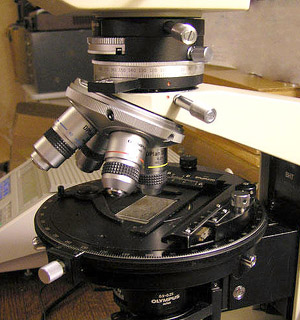In recent years, it has become
possible to obtain a high-quality used bench top
polarizing microscope for a small fraction of its
new price, so that a step up from a student or
less-capable model is feasible even for modest
pockets (as in my case). Although certainly not a
trivial cost, you might with some work and luck
find a very good machine for a price between US
$1000 and $2000 (about 800 to 1600 Euros),
although with an expectation that the product will
need some cleaning, adjusting, and likely another
accessory or two. Yes, there are number of used or
even new student-size pol scopes available for
less money, and they mostly function OK, but they
are at another level and that is another
article.
How to Get One?
If a dealer is nearby, you might call or visit—even new microscope dealers might have some good "pre-owned" machines in stock. There are always nice examples for sale by dealers on the internet, which can be found with a search engine such as Google or Yahoo. The hang-up here might be cost. You will note right away that prices for polarizing microscopes are half-again to double the cost for biological brightfield versions of the same model. Asking prices for like-new used bench top polarizing microscopes from dealers can run from $4000 to $8000, sometimes higher. Pol scopes start out at a higher price when new because parts for pol scopes are more expensive to produce, and they are sold in much smaller numbers than biological models, so it is a matter of production costs. In addition, a dealer will add value by cleaning, adjusting, repairing, replacing parts, testing, and guaranteeing a complex machine, which has to be reflected in the price. But if you have the where-with-all, buying from a dealer will almost certainly mean your instrument is in good function and good condition, and if it is not, you have some recourse. Dealers want and need happy customers.
But then, like your fellow microscopists around the globe, you could watch what comes up at internet auction sites such as eBay. Here final prices are often a bargain, sometimes ridiculously low (10% to 20% of new cost), but obviously there is a real risk that what arrives (eventually) is less than satisfactory. Assuming this is your route, what might you find with a price between $1000 to $2000 or so, using a bargain source such as eBay? And, what should you know about the particular makes and models, other than what the seller describes or you can glean from the internet?
In this article, I will describe six of the best research-quality bench top polarizing microscopes, made from the 1970s to 1990s, that I have direct experience with, and have seen in various conditions for sale on eBay. Why that age range? The major companies made significant improvements in optics and functionality after the 1960s, achieving excellent mechanical quality as well. The modular parts that are needed for polarizing microscopes were perfected, and have not changed much since then. Starting in the 1990s, the big companies re-developed their instrument lines into what appear to be more sophisticated models, usually with infinity tube-length optics and ergonomic, stylish designs. They are, no doubt, superlative machines. But the people and companies that bought them new are still using them, so relatively few are as yet available on the used microscope market. And, they are expensive. More to the point, I have very little personal experience with 21st century scopes. From my perspective, the 1970s to 1990s were the golden age of microscopes.
Disclaimer
It is understandable that you might object to some of my characterizations, or complain that I have left out a microscope you know to be top-notch. My descriptions are naturally subjective, and limited to machines I have actually worked with. Also, I am not a professional microscopist or trained service technician. However, my experience includes at least as many others that in my judgment are not quite as good, even if all of them have certain fine qualities. In truth, I have never met a geological microscope I did not like.
Criteria for Judging Pol Microscopes
Assuming good used condition (unmarked glass, clear filters, clean machine, nothing broken, all functional, not abused), criteria for judging petrographic microscopes include:
Lighting. Geological microscopes need a bright light source because of light loss by the polarizing filters. Also, cross-polar views need to be evenly lit to judge differences in birefringence across the view. There should be a diaphragm (iris) below the field lens and another at an adjustable condenser, so that you can achieve Kohler illumination. Newer systems use a halogen lamp, either pre-focused or adjustable, which is cheap and easy to replace.
Focus controls should be neither loose nor too tight. The best systems have tightness or tension that can be adjusted by the user without any disassembly, usually related to the coarse focusing knobs. Minerals often have structures that can be studied by slightly changing the focal plane, so there needs to be smoothness and precision.
Angular rotational scales and controls. The circular stage should have degree gradations (a goniometer), with a stop screw and (possibly) audible clicks at regular intervals. One eyepiece needs a focusable crosshair reticle (micrometer marks on it are a plus), and the eyepiece might lock in place with a pin and slot. The polarizing filters must be properly aligned, so that extinction angles can be studied and measured (with the stage scale) relative to the crosshair. It is helpful if one or both pol filters can be rotated according to degree scales, and to be sure of angles relative to a compensating plate.
Ease of centering the objectives, the circular stage, and the condenser, so that the view and the stage rotate around the same center point. A good system has centering screws that work smoothly and do not allow individual objectives to wander off center. The stage also should be easy to center with screws or bolts (relative to one or more of the objectives), and it will stay that way during use.
Accessories. Because they often are not included in used scope sales, accessories need to be available for adding later, either through eBay or via commercial sources. They tend to be expensive. All good pol systems need one or more light-wave compensating plates, at least a whole-wave (1st order red) and if possible a ¼ wave (mica) plate, and maybe a quartz wedge. Although the older 4x12 mm plate size is fine, the newer size of 6x20 mm indicates a larger, brighter, light pathway. It is also really nice, but not absolutely necessary, to have a smooth-operating x-y mechanical slide holder on the stage. They are made with low or horizontal control knobs that will not interfere with objectives when the stage is rotated. Hard to find, and expensive when you find one.
Bertrand lens. Conoscopic observations with petrographic microscopes assist the identification of minerals, and sometimes to estimate their compositions as well. It is possible to pull off an eyepiece and look down the tube for this purpose, but every good pol scope will provide a Bertrand lens instead (same tool as used to center phase contrast rings). It will be built into the head, or in an intermediate tube beneath the head, and it can be moved into or out of the light path. The best machines will also provide a way to focus it. To help make a proper concentrated light cone, the condenser should have a flip-up top lens for this higher-power conoscopic observation.
Optical quality. You should expect wide, sharp, planar views, with good contrast and brightness. The polarizing filters should be responsible for any and all birefringence in the minerals under study. The problem of optical parts adding their own polarization (in unwanted directions) is why companies have to put extra effort, and money, into designing and constructing pol parts. Pol scope optics are said to be strain-free, that is, their glass is cooled and lenses constructed so that they add no polarizing effects. In addition, such effects from internal glass layers in the lenses, mirrors, refractors, and prisms have to be designed out. Binocular heads, with their extra prisms and mirrors, are especially harder (and more expensive) to make for pol scopes than are monocular heads. This is why monocular heads have been especially common in polarizing systems, even at the higher end. However, the best pol scopes in my benchtop group will offer both binocular and trinocular heads, and you should have one or the other.
Objectives and oculars. Many rocks are coarse enough to require low power objectives. A good system will have at least 2.5 or 4x, 10x, and 40x pol (P or Po) objectives, and as a 4th piece, a 20x or 60x is more useful than a 100x objective. The 40x power is also used for conoscopic observations. Expect good plan achromats. Also in the best pol scope, the eyepieces should be widefield, high-eyepoint types. Top systems might use objectives that are paired with specific compensating eyepieces, designed to work together. Here is a poorly-kept secret: many 'regular' non-pol objectives of good quality will work fine in a polarizing microscope, without noticeable strain effects.
Look and feel. The best microscopes have parts that move smoothly and easily where they should, but are rigid and solid where they should not. They have close tolerances, polished contact surfaces, metal gears, ball bearings, and good finishes. Lesser machines have eyepieces that rattle around, condensers that will not stay put, stages that stick or wobble, objectives not parfocal — it goes on and on. The frame should be strong, solid, and heavy, especially if you are going to take photomicrographs. Your hands should fall naturally to the controls, and various parts should be easily found when needed and out of the way when not needed. And it should be good looking — aesthetics are important. These things affect your pleasure in owning and using any microscope.
Maintainability. Finally, the best scopes can be disassembled and reassembled as needed for cleaning, lubricating, adjusting, and repairing. That ability makes regular care a lot easier, and with it a quality microscope will provide fine service for a life time.
The Top Picks
Six machines represent my picks of the best used polarizing microscopes with affordable prices, meaning less than $2000 or so in an auction setting (fixed-price dealers, including me, might want more than that). I have put them in order of likely cost and my personal preference, with the best one last.
Leitz Dialux, Early 1970s
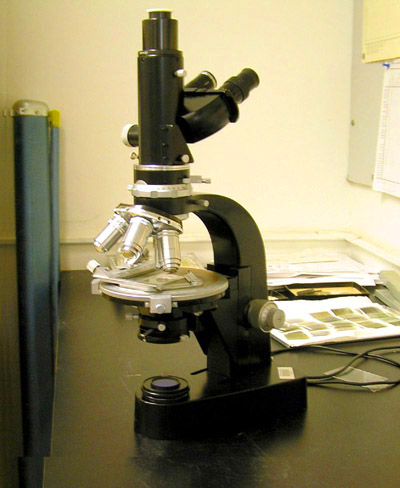 Leitz deserves the high esteem that owners and
users hold for their products of the pre-Leica
years. The black Ortholux and Dialux pol scopes of
the 1960's and early 70's are close to the look
and feel of their superlative contemporary, the
Wild Heerbrugg M21, and Leitz sure sold a lot more
(in the USA anyway), so many parts and accessories
are available on the market. In the 80s, Leitz
changed over to a blue-gray rectangular-box design
for its scope stands, which were newer looking but
(I am told) not better machines.
Leitz deserves the high esteem that owners and
users hold for their products of the pre-Leica
years. The black Ortholux and Dialux pol scopes of
the 1960's and early 70's are close to the look
and feel of their superlative contemporary, the
Wild Heerbrugg M21, and Leitz sure sold a lot more
(in the USA anyway), so many parts and accessories
are available on the market. In the 80s, Leitz
changed over to a blue-gray rectangular-box design
for its scope stands, which were newer looking but
(I am told) not better machines.
I spent portions of several days cleaning and adjusting a Leitz Dialux that is actively used by a fellow academic geologist. After 35 years it shows only minor wear, and it could probably give perfect satisfaction for another 35 years, at least. He remembers a price around $4500 in 1971, with another $1500 for a kit of accessories including wave plates and a mechanical x-y point-counting stage.
This one has five large,
excellent objectives, marked PL 2.5/0.08 170/-,
10/0.25 P 170/-, NPL 16/0.40 P 170/-, NPL 40/0.65
P 170/0.17, and P 63/0.85 170/017. The turret is
large enough to hold all five plus centering
screws for them. The trinocular head has a
Bertrand lens built into it, and uses Periplan
GF10x eyepieces. Both the analyzer and the
polarizer filters can rotate, with a slot for the
4x12 wave plates in the intermediate tube. There
is a separate power source for the 15 watt
tungsten filament
lamp.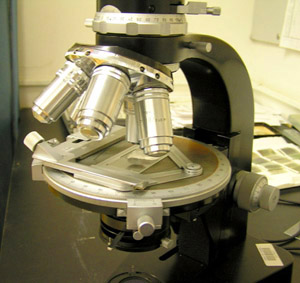
For some reason, in many photos the Dialux looks rather small, but in fact it is a full-sized bench top machine, not a portable student stand. Its heavy, rigid frame is very good for photomicrography. Some people who wish to adapt certain digital cameras (such as the Nikon Coolpix 990/995) seek out a Periplan objective that has a screw-on eye-guard (this example does not). After removing the eye-guard, the threads are the right size to screw the objective directly onto the Nikon. It then becomes an excellent photo relay lens that can slide into the trinocular tube and easily hold the light weight camera.
You might think that people who use this older black-enamel style will envy geologists who have newer machines, but at least in this case, my colleague knows that his Leitz is close to the acme of function and design in petrographic microscopes. But not everyone has his insight, so you might find a real bargain price for this model.
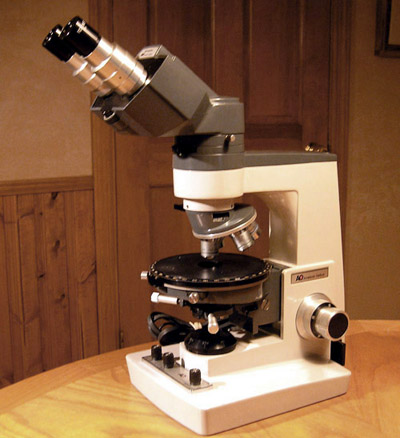 The four A.O. infinity-corrected advanced
plan-achromat objectives include a 4x/0.12,
10x/0.25, 20x/0.50, and a 40x/0.66. Also available
were 45x, 50x, and 100x objectives, although they
might not all be strain-free. They produce very
good, wide, sharp, high-contrast views. The
graduated circular stage is easily centered with
attached knobs, but there is no provision to
center objectives.
The four A.O. infinity-corrected advanced
plan-achromat objectives include a 4x/0.12,
10x/0.25, 20x/0.50, and a 40x/0.66. Also available
were 45x, 50x, and 100x objectives, although they
might not all be strain-free. They produce very
good, wide, sharp, high-contrast views. The
graduated circular stage is easily centered with
attached knobs, but there is no provision to
center objectives.
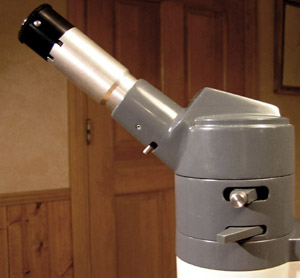
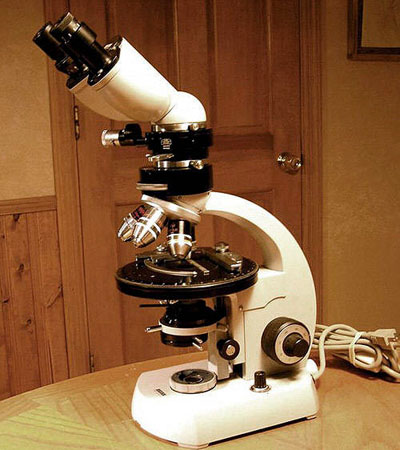 During our time frame, Zeiss made a very popular
polarizing petrographic microscope based on the
various Standard 14, 16, and 18 stands. It used
the famous Zeiss Pol objectives and one or two
intermediate tubes for polarizing accessories.
Zeiss pioneered modular designs with the Standard,
which soon became the norm for all makers. Many
options and accessories were produced, so a real
mix-and-match is possible for the numbered
variations.
During our time frame, Zeiss made a very popular
polarizing petrographic microscope based on the
various Standard 14, 16, and 18 stands. It used
the famous Zeiss Pol objectives and one or two
intermediate tubes for polarizing accessories.
Zeiss pioneered modular designs with the Standard,
which soon became the norm for all makers. Many
options and accessories were produced, so a real
mix-and-match is possible for the numbered
variations.
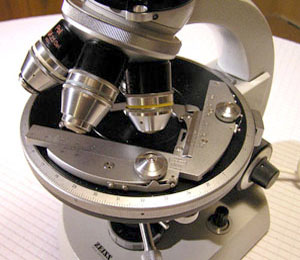
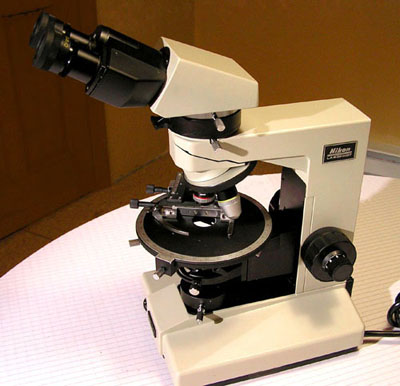 The Nikon Labophot was an "entry level" benchtop
scope, less expensive than the Optiphot line. I
have never seen an Optiphot pol scope, but the
same modular parts should fit either model. The
Labophot pol version has some interesting
features. A large whole-wave compensating filter
is permanently mounted in a filter holder over the
polarizer, which you can swing in and out and also
rotate. The polarizer (also rotatable) mounts in a
removable holder in the foot directly over the
field lens. The Achromat condenser has a flip-up
lens, iris, and centering screws. The graduated
circular stage is centerable. The analyzer is in a
slider plate in an intermediate tube accessory.
The binocular head has a built-in Bertrand lens on
a dial beneath the eyepiece tubes, which works
well. The eyepieces are Nikon CFW 10x, with one
being a focusing "CM" containing a crosshair with
a graduated horizontal axis. The 20-watt halogen
lamp is in a holder that plugs into the back of
the base, cheap and easy to change. There is an
on-off and light intensity dial in the
front.
The Nikon Labophot was an "entry level" benchtop
scope, less expensive than the Optiphot line. I
have never seen an Optiphot pol scope, but the
same modular parts should fit either model. The
Labophot pol version has some interesting
features. A large whole-wave compensating filter
is permanently mounted in a filter holder over the
polarizer, which you can swing in and out and also
rotate. The polarizer (also rotatable) mounts in a
removable holder in the foot directly over the
field lens. The Achromat condenser has a flip-up
lens, iris, and centering screws. The graduated
circular stage is centerable. The analyzer is in a
slider plate in an intermediate tube accessory.
The binocular head has a built-in Bertrand lens on
a dial beneath the eyepiece tubes, which works
well. The eyepieces are Nikon CFW 10x, with one
being a focusing "CM" containing a crosshair with
a graduated horizontal axis. The 20-watt halogen
lamp is in a holder that plugs into the back of
the base, cheap and easy to change. There is an
on-off and light intensity dial in the
front. 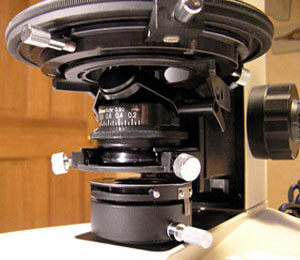
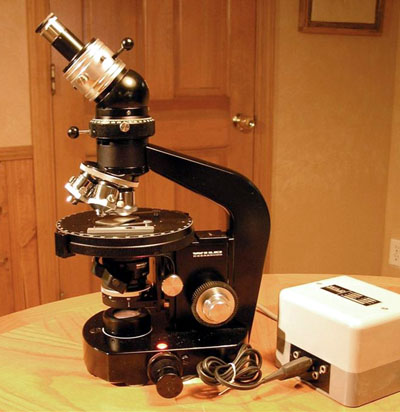 The four achromat objectives on my example are a
4/1.0 Pol, Pol 10/0.25, Pol 20/0.45, and Pol
40/0.65. A Pol 100/1.25 oil immersion lens was
available. The 20x, 40x, and 100x lenses have
spring-loaded tips to reduce contact damage. They
each have an easy if unique 2-knob centering
feature, and they fit into a quick-release turret
nosepiece. The head attached to a body tube with a
rotatable calibrated analyzer, and a slot for a
4x12 mm compensating plate. The large Pol (strain
free) condenser has a flip up top lens, a
diaphragm, and a swing-out filter holder. Beneath
that, a swing-out polarizing filter can be
rotated. The field lens is adjustable and a field
diaphragm is built into the light tube, so that
Kohler illumination can be achieved.
The four achromat objectives on my example are a
4/1.0 Pol, Pol 10/0.25, Pol 20/0.45, and Pol
40/0.65. A Pol 100/1.25 oil immersion lens was
available. The 20x, 40x, and 100x lenses have
spring-loaded tips to reduce contact damage. They
each have an easy if unique 2-knob centering
feature, and they fit into a quick-release turret
nosepiece. The head attached to a body tube with a
rotatable calibrated analyzer, and a slot for a
4x12 mm compensating plate. The large Pol (strain
free) condenser has a flip up top lens, a
diaphragm, and a swing-out filter holder. Beneath
that, a swing-out polarizing filter can be
rotated. The field lens is adjustable and a field
diaphragm is built into the light tube, so that
Kohler illumination can be achieved.
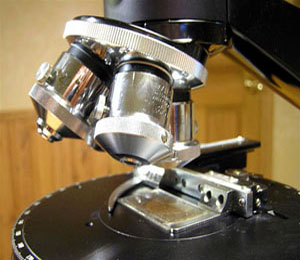
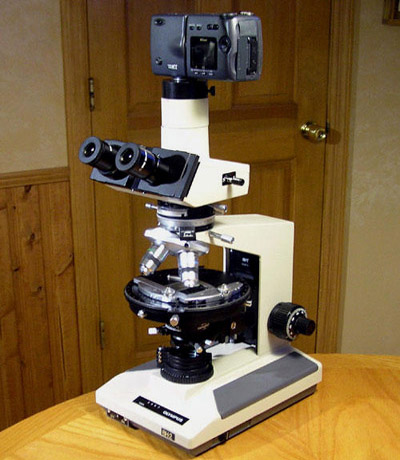 I have to confess up front that this particular
Olympus BH-2 BHTP (pol version of the BHT) is the
microscope I prefer over all others, including
some great very large research instruments I have
used in past years. It has taken me a long time
and a steady flow (or flux, as scientists might
say) of dollars to obtain and refurbish all of its
parts and accessories, but now that it purrs like
a kitten, I can tell you it was worth every penny
and frustration. It has earned a permanent and
revered place in my research lab.
I have to confess up front that this particular
Olympus BH-2 BHTP (pol version of the BHT) is the
microscope I prefer over all others, including
some great very large research instruments I have
used in past years. It has taken me a long time
and a steady flow (or flux, as scientists might
say) of dollars to obtain and refurbish all of its
parts and accessories, but now that it purrs like
a kitten, I can tell you it was worth every penny
and frustration. It has earned a permanent and
revered place in my research lab.
